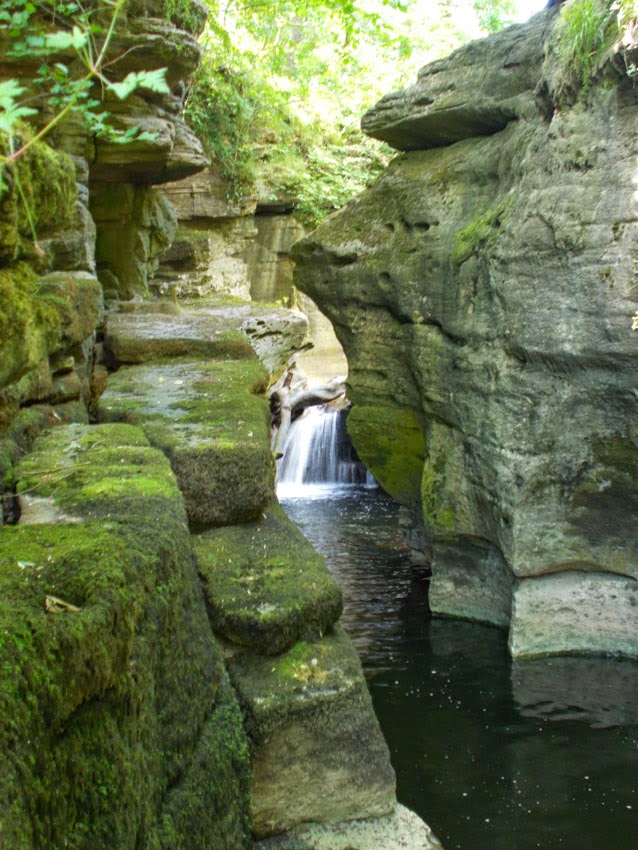Following the River - the Poetry Path
Today I walked upstream where the River Eden falls through a series of dramatic limestone 'kettles' and gorges and where the river coincides with an abandoned railway.
This is Stenkrith, at the entrance to Ravenstonedale, on the edge of the Pennines. What looks like a twig in the photo above, is actually the trunk of a tree washed down by floods. It's impossible to get any sense of scale with a camera, where the river drops from a high sill of rock (high as a multi-storey building), boiling over and under the stone, creating circular holes, deep pools and a dramatic gorge.
The sound it makes, even on a day when the water level is low, is like being on the edge of a thunderstorm, and the rock shakes with the percussion.
Today, reflected light from the water surface was creating holograms on the walls of the gorge.
The Stainmore Railway, from Kirkby Stephen to Barnard Castle, once ran on the edge of the gorge with fabulous views of the river and the Pennines. it was the second highest line in England, going up to 1370 feet above sea level. Like many small lines, it was axed by Dr Beeching, leaving the small communities here completely isolated. It opened in 1861 and closed in 1961.
Now, only walkers and cyclists use it. To celebrate its opening as a footpath, the poet Meg Peacocke was commissioned to write a series of short poems that were to be carved into stone along the river pathway. The calligrapher who carved them, used special fonts which are now - after years of weathering - very hard to read.
This is one of my favourites -
'Silage tractor incises the first
Green furrow - skillful geometrician
the driver judges an arc of weather'
There are still relics of the railway. This is a platelayers' hut. Does anyone nowadays know what a platelayer did?
And then there's the impressive Podgill Viaduct - 30 arches, more than 84 feet high - a feat of engineering designed by Cumbrian engineer Thomas Bouch who later designed the ill-fated Tay Bridge which collapsed in 1879 with considerable loss of life.
Bouch died later that year, aged 58, a devastated man. Fortunately Podgill is still standing.
Today was what in Cumbria we call a 'borrowed' day - because we know we're going to have to give it back! Such weather as this is something precious - tomorrow it will probably be raining. It isn't called The Lake District for nothing!
 |
| This is the top of the fall |
This is Stenkrith, at the entrance to Ravenstonedale, on the edge of the Pennines. What looks like a twig in the photo above, is actually the trunk of a tree washed down by floods. It's impossible to get any sense of scale with a camera, where the river drops from a high sill of rock (high as a multi-storey building), boiling over and under the stone, creating circular holes, deep pools and a dramatic gorge.
 |
| And this is at the bottom |
The sound it makes, even on a day when the water level is low, is like being on the edge of a thunderstorm, and the rock shakes with the percussion.
Today, reflected light from the water surface was creating holograms on the walls of the gorge.
The Stainmore Railway, from Kirkby Stephen to Barnard Castle, once ran on the edge of the gorge with fabulous views of the river and the Pennines. it was the second highest line in England, going up to 1370 feet above sea level. Like many small lines, it was axed by Dr Beeching, leaving the small communities here completely isolated. It opened in 1861 and closed in 1961.
Now, only walkers and cyclists use it. To celebrate its opening as a footpath, the poet Meg Peacocke was commissioned to write a series of short poems that were to be carved into stone along the river pathway. The calligrapher who carved them, used special fonts which are now - after years of weathering - very hard to read.
This is one of my favourites -
'Silage tractor incises the first
Green furrow - skillful geometrician
the driver judges an arc of weather'
There are still relics of the railway. This is a platelayers' hut. Does anyone nowadays know what a platelayer did?
And then there's the impressive Podgill Viaduct - 30 arches, more than 84 feet high - a feat of engineering designed by Cumbrian engineer Thomas Bouch who later designed the ill-fated Tay Bridge which collapsed in 1879 with considerable loss of life.
Bouch died later that year, aged 58, a devastated man. Fortunately Podgill is still standing.
Today was what in Cumbria we call a 'borrowed' day - because we know we're going to have to give it back! Such weather as this is something precious - tomorrow it will probably be raining. It isn't called The Lake District for nothing!








Beautiful photographs! And poignant words. (Platelayer?)
ReplyDeleteI had to look up the word myself - they were railway makers and maintenance men who laid a special kind of track used mainly by coal trucks. There's more info here http://www.theplatelayers.org/pltname.htm Ah! the romance of steam!
Delete